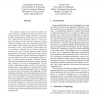50 search results - page 10 / 10 » Design Concepts in Architecture: the Porosity Paradigm |
AICCSA
2005
IEEE
14 years 25 days ago
2005
IEEE
Autonomic Computing was introduced to reduce the complexity of managing computing systems; however, the heterogeneous nature existing in most computing systems introduces some dif...
ECOOP
2008
Springer
14 years 18 days ago
2008
Springer
Abstract. The paradigm shift in processor design from monolithic processors to multicore has renewed interest in programming models that facilitate parallelism. While multicores ar...
CNSR
2005
IEEE
14 years 24 days ago
2005
IEEE
The dramatic increase in the number of mobile subscribers has put a significant resource and service provisioning strain on current cellular networks in particular in terms of mu...
EUROGP
2005
Springer
14 years 4 months ago
2005
Springer
Abstract. Wireless sensor networks (WSNs) are medium scale manifestations of a paintable or amorphous computing paradigm. WSNs are becoming increasingly important as they attain gr...
HICSS
2007
IEEE
14 years 5 months ago
2007
IEEE
Systems using Software Agents (or Multi-Agent Systems, MAS) are becoming more popular within the development mainstream because, as the name suggests, an Agent aims to handle task...

